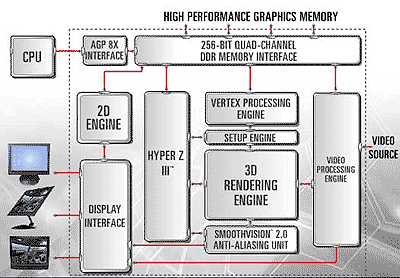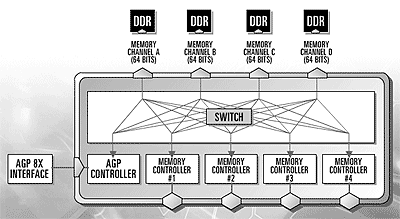
There's so much to the Radeon 9700 Pro technology that it
really makes you want to sit back for a moment and marvel at just how far
desktop graphics cards have come - it's truly a great time to be a gamer. As you
can see, the ATI R300 core incorporates 8x AGP, a Quad channel DDR memory
controller, Vertex engine and Hyper Z III just to name a few features.
The Radeon 9700 Pro is the second videocard on the market
(as of this writting) to fully support 8x AGP (the first was the SiS Xabre
GPU). What 8x AGP essentially does is double the available bandwidth between the
rest of the computer and the videocard. This basically means that various data
(shaders, 3D models, textures, etc) can travel to to the GPU and back
potentially twice as fast. The peak
bandwidth that 8x AGP offers is 2.1 GB/s up from 1.06 GB/s with 4x
AGP.

ATI have already "one upped" the competition by using a
256 bit memory controller which provides up to 20 GB/s worth of bandwidth to
the R300 core (nVIDIA's GeForce line of cards all use 128
bit controllers).
The
memory controller breaks up the 256 bit wide bus into four separate, yet independent, smaller 64 bit controllers. The reason behind this is
based on the assumption that the computer is not always going to fill the 256 bit with data. Sometimes
there will be only 64 bits, or maybe 96 bits worth of
data.
Using the whole 256 bit
controller to send 64 bits of data is a big waste of bandwidth ,and very
inefficient. With these smaller independent 64 bit controllers, when you only
need to send 64 bits worth of data, you're only going to be sending 64 bits of
data. That allows the other three 64 bit controllers to be freed
up.
Lastly on the memory front, as I'm sure you are already well
aware, the Radeon 9700 Pro uses DDR memory. Interestingly enough, the
memory controller is also compatible with DDR-II.
This may come in very handy when Intel release their "Granite-Bay" chipset which is supposed to
be DDR-II compatible.
